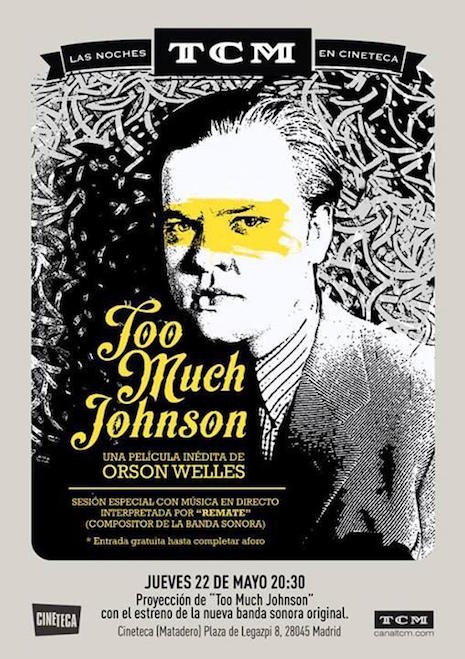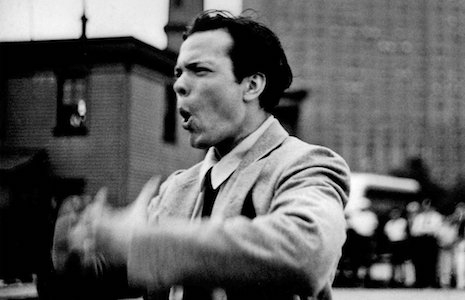
Scene: A suite at the St. Regis Hotel, New York City, 1938. The floor is knee-deep in coils of highly flammable nitrate film. It sprawls across the floor, hangs from light fittings, bedposts, armchairs, tables, and glistens like a pit of malevolent serpents.
Center of the room stands boy wonder, Orson Welles, fueled by coffee and brandy and chicken sandwiches. He stands, puffing on an oversized pipe, filling the room with big black cartoon clouds of train engine smoke punctuated with angry fireflies of tobacco sparks which threaten (at any moment) to set the whole place alight. Welles is intently staring at one roll of film he slides up and down between his hands. He is oblivious to the chaos and possible fatal disaster that surrounds him.
His assistant John Berry is wrestling with a movie projector on which a roll of film has become snagged and is now kindling to a burst of yellow flames. Berry carries the projector back-and-forth anxiously looking for a safe place to dump the now smoking machinery. In front of him, like the best stage farce, a selection of doors offer escape but all are closed shut.
At one, there is a-knocking of someone wanting to get in. The door opens hesitantly. It’s producer John Houseman who has come to see what’s going on with the latest project Too Much Johnson. Houseman enters, retreats, enters, retreats, as if shyly rehearsing dance steps. He eventually opens the door wide, coughs once, then enters the room. He opens his mouth to speak but the shock of seeing 25,000 feet of highly flammable film decorating the floor, Berry with a burning projector seeking escape, and an oblivious Welles smoking like a volcano is all too much for him. He attempts to retreat back to the hallway while comically elbowing Berry over who gets out first.
Exit Houseman and Berry with flaming projector.
This is roughly around the moment when Orson Welles fell in love with movie-making and decided making movies was to be his future career.

Orson Welles making magic out of thin air.
Welles and Houseman were the bright young bucks of NY theater. Their innovative, critically acclaimed, and highly successful productions of an all-black Macbeth in 1936, followed by Marc Blitzstein‘s socialist musical The Cradle Will Rock, led Welles and Houseman to form their own repertory company the Mercury Theatre in 1937. Their first production as the Mercury Theatre was a jack-booted, militaristic production of Shakespeare’s Julius Caesar called Caesar. It earned the pair column inches of praise and reputations as a major force in American theater.
In 1938 came productions of The Shoemaker’s Holiday and George Bernard Shaw’s Heartbreak House. Both of these received five-star reviews for their direction, acting, and original and creative approach to theater. Welles was always thinking up new and fresh ways to present well-known dramas. The Mercury’s next production was to be William Gillette‘s farce, about the misadventures of an amorous young man, Too Much Johnson which was more Welles’ baby than the “scholarly” Houseman’s, who was left to raise the cash and carry props. Gillette was the American actor who was famous for his character-defining performance of Sherlock Holmes—an interpretation that gave Arthur Conan-Doyle’s fictional hero many of the accessories, mannerisms, and tics still associated today with the renowned Baker Street sleuth.
Thinking of how to make Too Much Johnson seem new and original for the audience, Welles decided on filming a twenty-minute introduction to the play, with two ten minute sequences to be screened before acts two and three. There was no money to shoot these inserts, so Welles begged and borrowed and cajoled Houseman to raise whatever cash he could find. Too Much Johnson was to open at the Stony Creek Theatre in Connecticut. Welles was going to use the stage actors to perform in the inserts but gave so much of his time over to working on his filmed inserts, he left himself little time to focus on directing the actors for the stage production. Not that Welles was bothered—he was keen on improvising parts of the stage show.
Filming started in July 1938 amid all of Welles other commitments to radio, writing, and directing other productions.
Watch ‘Too Much Johnson,’ after the jump…





